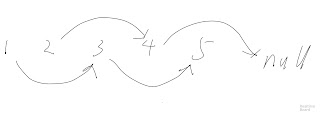112. Path Sum
Problem: Given a binary tree and a sum, determine if the tree has a root-to-leaf path such that adding up all the values along the path equals the given sum. For example: Given the below binary tree and sum = 22 , 5 / \ 4 8 / / \ 11 13 4 / \ \ 7 2 1 return true, as there exist a root-to-leaf path 5->4->11->2 which sum is 22. Analysis: From top to bottom, subtract sum by root.val. Once reach bottom, check whether val minus remaining sum == 0. Solution: /** * Definition for a binary tree node. * public class TreeNode { * int val; * TreeNode left; * TreeNode right; * TreeNode(int x) { val = x; } * } */ class Solution { public boolean hasPathSum(TreeNode root, int sum) { if (root == null) return false; if (root.left == null && root.right == null && root.val - sum == 0) retu...
